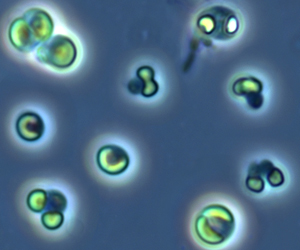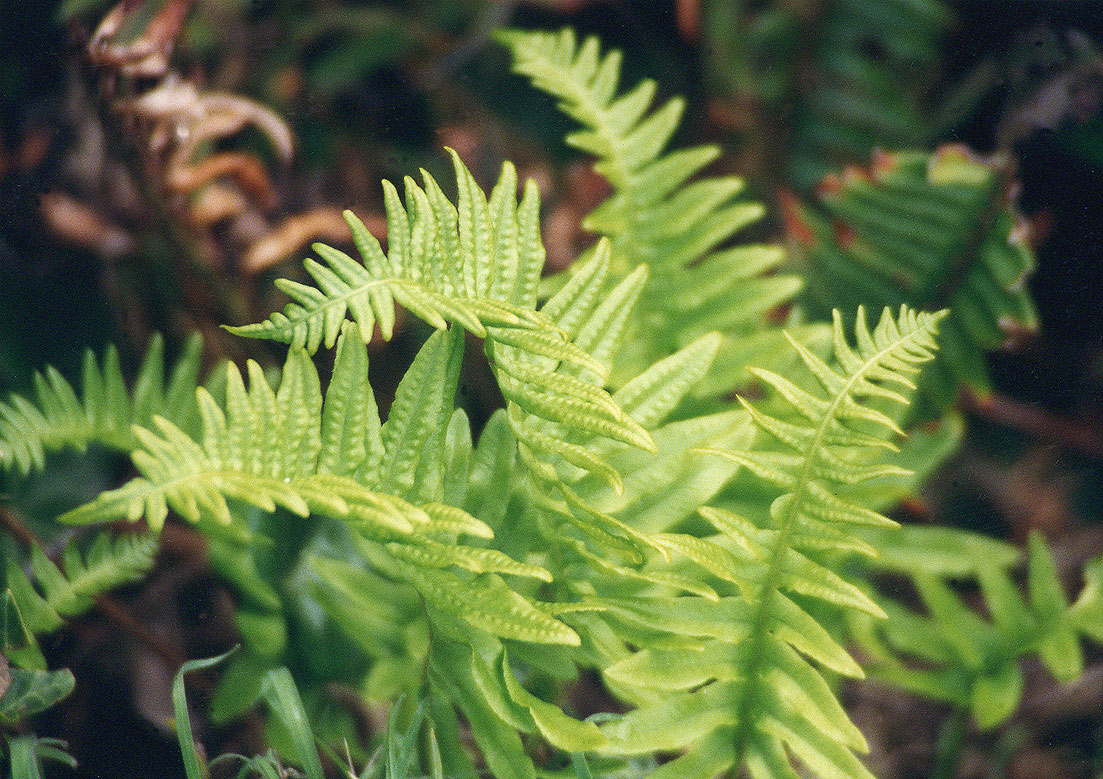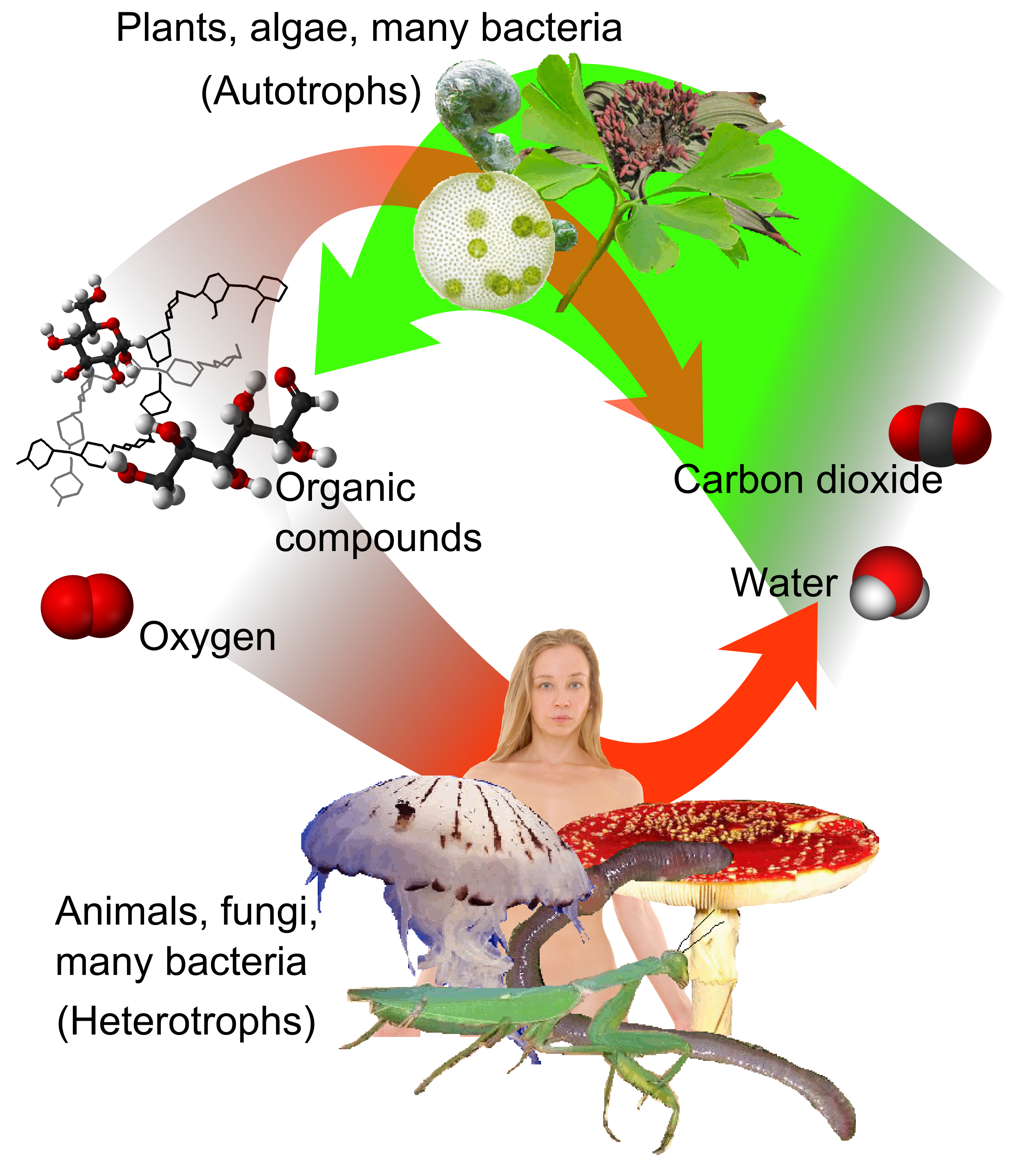|
Green Alga
The green algae (: green alga) are a group of chlorophyll-containing autotrophic eukaryotes consisting of the phylum Prasinodermophyta and its unnamed sister group that contains the Chlorophyta and Charophyta/ Streptophyta. The land plants ( Embryophytes) have emerged deep within the charophytes as a sister of the Zygnematophyceae. Since the realization that the Embryophytes emerged within the green algae, some authors are starting to include them. The completed clade that includes both green algae and embryophytes is monophyletic and is referred to as the clade Viridiplantae and as the kingdom Plantae. The green algae include unicellular and colonial flagellates, most with two flagella per cell, as well as various colonial, coccoid (spherical), and filamentous forms, and macroscopic, multicellular seaweeds. There are about 22,000 species of green algae, many of which live most of their lives as single cells, while other species form coenobia (colonies), long filaments, or ... [...More Info...] [...Related Items...] OR: [Wikipedia] [Google] [Baidu] |
Picocystophyceae
''Picocystis'' is a monotypic genus of green algae, the sole species is ''Picocystis salinarum''. It is placed within its own class, Picocystophyceae in the division Chlorophyta. Structure ''Picocystis salinarum'' cells under normal conditions have a spherical or oval shape. Their size ranges from 2 to 3 μm in diameter. Under conditions of nutrient depletion they appear to form a trillobe shape. This trillobe shape gives it the nickname Mickey Mouse, due to its appearance to the famous character's head. The general appearance resembles that of a standard green alga. The pigments are composed mainly from chlorophyll a and b and the carotenoids violaxanthin, alloxanthin, monadoxanthin, neoxanthin, lutein, diatoxanthin and zeaxanthin. The cell wall is mainly composed of polymers of the monosaccharide arabinose, polyarabinose. Habitat The species have been found in saline or hypersaline alkaline In chemistry, an alkali (; from the Arabic word , ) is a basic salt of ... [...More Info...] [...Related Items...] OR: [Wikipedia] [Google] [Baidu] |
Mesostigmatophyceae
The Mesostigmatophyceae are a class of basal green algae found in freshwater. In a narrow circumscription, the class contains a single genus, '' Mesostigma''. AlgaeBase AlgaeBase is a global species database of information on all groups of algae, both seaweed, marine and freshwater algae, freshwater, as well as sea-grass. History AlgaeBase began in March 1996, founded by Michael D. Guiry, Michael Guiry. Text ... then places the class within its circumscription of Charophyta. A clade containing '' Chlorokybus'' and '' Spirotaenia'' may either be added, or treated as a sister, with ''Chlorokybus'' placed in a separate class, Chlorokybophyceae. When broadly circumscribed, Mesostigmatophyceae may be placed as sister to all other green algae, or as sister to all Streptophyta. References External links * AlgaTerra databaseIndex Nominum Genericorum Green algae classes Charophyta {{green algae-stub ... [...More Info...] [...Related Items...] OR: [Wikipedia] [Google] [Baidu] |
Monophyletic
In biological cladistics for the classification of organisms, monophyly is the condition of a taxonomic grouping being a clade – that is, a grouping of organisms which meets these criteria: # the grouping contains its own most recent common ancestor (or more precisely an ancestral population), i.e. excludes non-descendants of that common ancestor # the grouping contains all the descendants of that common ancestor, without exception Monophyly is contrasted with paraphyly and polyphyly as shown in the second diagram. A ''paraphyletic'' grouping meets 1. but not 2., thus consisting of the descendants of a common ancestor, excepting one or more monophyletic subgroups. A '' polyphyletic'' grouping meets neither criterion, and instead serves to characterize convergent relationships of biological features rather than genetic relationships – for example, night-active primates, fruit trees, or aquatic insects. As such, these characteristic features of a polyphyletic grouping ... [...More Info...] [...Related Items...] OR: [Wikipedia] [Google] [Baidu] |
Clade
In biology, a clade (), also known as a Monophyly, monophyletic group or natural group, is a group of organisms that is composed of a common ancestor and all of its descendants. Clades are the fundamental unit of cladistics, a modern approach to taxonomy adopted by most biological fields. The common ancestor may be an individual, a population, or a species (extinct or Extant taxon, extant). Clades are nested, one in another, as each branch in turn splits into smaller branches. These splits reflect evolutionary history as populations diverged and evolved independently. Clades are termed ''monophyletic'' (Greek: "one clan") groups. Over the last few decades, the cladistic approach has revolutionized biological classification and revealed surprising evolutionary relationships among organisms. Increasingly, taxonomists try to avoid naming Taxon, taxa that are not clades; that is, taxa that are not Monophyly, monophyletic. Some of the relationships between organisms that the molecul ... [...More Info...] [...Related Items...] OR: [Wikipedia] [Google] [Baidu] |
Embryophyte
The embryophytes () are a clade of plants, also known as Embryophyta (Plantae ''sensu strictissimo'') () or land plants. They are the most familiar group of photoautotrophs that make up the vegetation on Earth's dry lands and wetlands. Embryophytes have a common ancestor with green algae, having emerged within the Phragmoplastophyta clade of freshwater charophyte green algae as a sister taxon of Charophyceae, Coleochaetophyceae and Zygnematophyceae. Embryophytes consist of the bryophytes and the polysporangiophytes. Living embryophytes include hornworts, liverworts, mosses, lycophytes, ferns, gymnosperms and angiosperms (flowering plants). Embryophytes have diplobiontic life cycles. The embryophytes are informally called "land plants" because they thrive primarily in terrestrial habitats (despite some members having evolved secondarily to live once again in semiaquatic/ aquatic habitats), while the related green algae are primarily aquatic. Embryophytes are complex ... [...More Info...] [...Related Items...] OR: [Wikipedia] [Google] [Baidu] |
Land Plant
The embryophytes () are a clade of plants, also known as Embryophyta (Plantae ''sensu strictissimo'') () or land plants. They are the most familiar group of photoautotrophs that make up the vegetation on Earth's dry lands and wetlands. Embryophytes have a common ancestor with green algae, having emerged within the Phragmoplastophyta clade of freshwater charophyte green algae as a sister taxon of Charophyceae, Coleochaetophyceae and Zygnematophyceae. Embryophytes consist of the bryophytes and the polysporangiophytes. Living embryophytes include hornworts, liverworts, mosses, lycophytes, ferns, gymnosperms and angiosperms (flowering plants). Embryophytes have biological life cycle, diplobiontic life cycles. The embryophytes are informally called "land plants" because they thrive primarily in Terrestrial ecosystem, terrestrial habitats (despite aquatic plant, some members having evolved secondarily to live once again in semiaquatic/aquatic habitats), while the related green algae ar ... [...More Info...] [...Related Items...] OR: [Wikipedia] [Google] [Baidu] |
Streptophyta
Streptophyta (), informally the streptophytes (, from the Greek ''strepto'' 'twisted', for the morphology of the sperm of some members), is a clade of plants. The composition of the clade varies considerably between authors, but the definition employed here includes land plants and all green algae except the Chlorophyta and the more basal Prasinodermophyta. Classifications The composition of Streptophyta and similar groups (Streptophytina, Charophyta) varies in each classification. Some authors include only the Charales and Embryophyta (e.g., Streptophyta, Streptophytina); others include more groups (e.g., Charophyta, Streptophyta, Streptobionta); some authors use this broader definition, but exclude the Embryophyta (e.g., Charophyta, Charophyceae, Streptophycophytes). The clade Streptophyta includes both unicellular and multicellular organisms. Streptophyta contains the freshwater charophyte green algae and all land plants that reproduce sexually by conjugation. ''Mesostigma ... [...More Info...] [...Related Items...] OR: [Wikipedia] [Google] [Baidu] |
Charophyta
Charophyta () is a paraphyletic group of freshwater green algae, called charophytes (), sometimes treated as a division, yet also as a superdivision. The terrestrial plants, the Embryophyta emerged deep within Charophyta, possibly from terrestrial unicellular charophytes, with the class Zygnematophyceae as a sister group. With the Embryophyta now cladistically placed in the Charophyta, it is a synonym of Streptophyta. The sister group of the charophytes are the Chlorophyta. In some charophyte groups, such as the Zygnematophyceae or conjugating green algae, flagella are absent and sexual reproduction does not involve free-swimming flagellate sperm. Flagellate sperm, however, are found in stoneworts ( Charales) and Coleochaetales, orders of parenchymatous charophytes that are the closest relatives of the land plants, where flagellate sperm are also present in all except the conifers and flowering plants. Fossil stoneworts of early Devonian age that are similar to those of ... [...More Info...] [...Related Items...] OR: [Wikipedia] [Google] [Baidu] |
Sister Group
In phylogenetics, a sister group or sister taxon, also called an adelphotaxon, comprises the closest relative(s) of another given unit in an evolutionary tree. Definition The expression is most easily illustrated by a cladogram: Taxon A and taxon B are sister groups to each other. Taxa A and B, together with any other extant or extinct descendants of their most recent common ancestor (MRCA), form a monophyletic group, the clade AB. Clade AB and taxon C are also sister groups. Taxa A, B, and C, together with all other descendants of their MRCA form the clade ABC. The whole clade ABC is itself a subtree of a larger tree which offers yet more sister group relationships, both among the leaves and among larger, more deeply rooted clades. The tree structure shown connects through its root to the rest of the universal tree of life. In cladistic standards, taxa A, B, and C may represent specimens, species, genera, or any other taxonomic units. If A and B are at the same taxono ... [...More Info...] [...Related Items...] OR: [Wikipedia] [Google] [Baidu] |
Eukaryote
The eukaryotes ( ) constitute the Domain (biology), domain of Eukaryota or Eukarya, organisms whose Cell (biology), cells have a membrane-bound cell nucleus, nucleus. All animals, plants, Fungus, fungi, seaweeds, and many unicellular organisms are eukaryotes. They constitute a major group of Outline of life forms, life forms alongside the two groups of prokaryotes: the Bacteria and the Archaea. Eukaryotes represent a small minority of the number of organisms, but given their generally much larger size, their collective global biomass is much larger than that of prokaryotes. The eukaryotes emerged within the archaeal Kingdom (biology), kingdom Asgard (Archaea), Promethearchaeati and its sole phylum Promethearchaeota. This implies that there are only Two-domain system, two domains of life, Bacteria and Archaea, with eukaryotes incorporated among the Archaea. Eukaryotes first emerged during the Paleoproterozoic, likely as Flagellated cell, flagellated cells. The leading evolutiona ... [...More Info...] [...Related Items...] OR: [Wikipedia] [Google] [Baidu] |
Autotroph
An autotroph is an organism that can convert Abiotic component, abiotic sources of energy into energy stored in organic compounds, which can be used by Heterotroph, other organisms. Autotrophs produce complex organic compounds (such as carbohydrates, fats, and proteins) using carbon from simple substances such as carbon dioxide,Morris, J. et al. (2019). "Biology: How Life Works", 3rd edition, W. H. Freeman. generally Photosynthesis, using energy from light or Chemosynthesis, inorganic chemical reactions. Autotrophs do not need a living source of carbon or energy and are the primary production, producers in a food chain, such as plants on land or algae in water. Autotrophs can Redox, reduce carbon dioxide to make organic compounds for biosynthesis and as stored chemical fuel. Most autotrophs use water as the reducing agent, but some can use other hydrogen compounds such as hydrogen sulfide. The primary production, primary producers can convert the energy in the light (phototrop ... [...More Info...] [...Related Items...] OR: [Wikipedia] [Google] [Baidu] |
Chlorophyll
Chlorophyll is any of several related green pigments found in cyanobacteria and in the chloroplasts of algae and plants. Its name is derived from the Greek words (, "pale green") and (, "leaf"). Chlorophyll allows plants to absorb energy from light. Those pigments are involved in oxygenic photosynthesis, as opposed to bacteriochlorophylls, related molecules found only in bacteria and involved in anoxygenic photosynthesis. Chlorophylls absorb light most strongly in the blue portion of the electromagnetic spectrum as well as the red portion. Conversely, it is a poor absorber of green and near-green portions of the spectrum. Hence chlorophyll-containing tissues appear green because green light, diffusively reflected by structures like cell walls, is less absorbed. Two types of chlorophyll exist in the photosystems of green plants: chlorophyll ''a'' and ''b''. History Chlorophyll was first isolated and named by Joseph Bienaimé Caventou and Pierre Joseph Pelletier in ... [...More Info...] [...Related Items...] OR: [Wikipedia] [Google] [Baidu] |





